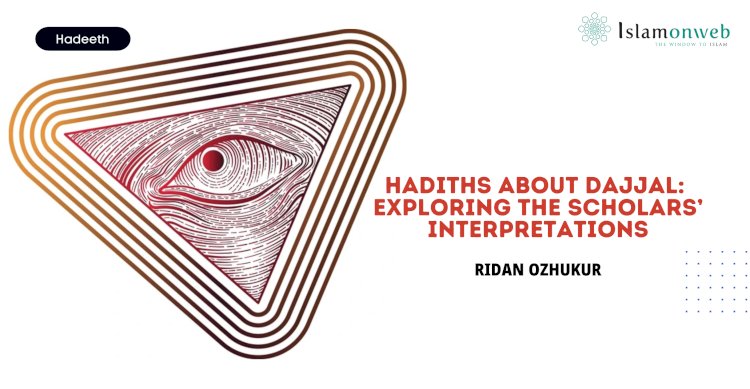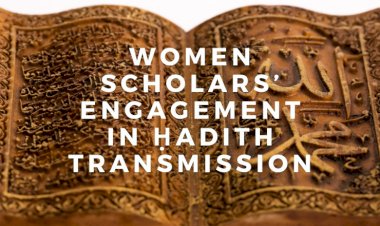Hadiths about Dajjal: Exploring the Scholars’ Interpretations
The figure of Dajjal has long been a source of fear and fascination in Islamic eschatology. Traditional theological texts reveal numerous accounts of Dajjal, who is prophesied to appear as a great sedition before the Day of Judgement. According to a narration by Anas ibn Malik (R), the Messenger of Allah (PBUH) said, "There was no prophet but he has warned his people against the one-eyed liar" (Muttafiqun alaihi).
The primary reason for the Prophet's warnings against Dajjal's appearance is the unparalleled chaos he will bring. He is described as a massive fitnah (trial), unlike any seen before. Dajjal will commit mass murder of believers, and many will fall under his control, deceived by his supernatural feats. He will have the ability to make it rain, grow plants, and even revive the dead. Witnessing these miraculous acts, people will be misled into believing that he is divine. However, those whom Allah decides will be saved from his sedition.
Several hadiths detail Dajjal's characteristics. Anas ibn Malik (R) narrates that the Messenger of Allah (SAW) said: "Dajjal is one-eyed, and written between his eyes is 'Ka, fa, ra' (disbeliever)." In another narration, it is mentioned that this inscription will be readable by all Muslims.
Nawwas ibn Sam’an, another companion, reports a lengthy hadith in which the Prophet (SAW) describes Dajjal as a young man with long hair, emerging from the area between the Levant and Iraq. He will dwell on the earth for forty days, with one day as long as a year, one day as long as a month, one day as long as a week, and the remaining days like regular days. Dajjal will command the skies to rain and the earth to grow vegetation; those who believe in him will prosper, while those who reject his divinity will suffer severe punishment and poverty. Dajjal will tear a man in two and then bring him back to life in front of people. At this time, Allah will send Masih Isa (PBUH), who will descend at the white minaret of East Damascus, placing his palms on the wings of angels, and will kill Dajjal at the gate of Lod (a city in Israel).
These hadiths, relayed over fourteen centuries ago, describe events that seemed distant at the time. However, as the world evolves, especially in its ethical dimensions, connecting these hadiths with modern elements can make them more relevant to contemporary audiences. This study highlights interpretations of Dajjal's characteristics by various scholars, offering insights into their significance in today's context.
One-Eyed Dajjal
When we hear the term "one-eyed Dajjal," we might picture a figure with a single eye on his forehead, as depicted by some YouTubers. However, Dajjal is described as having two eyes, one of which is defective and unable to receive light. Some hadiths liken his eyes to ripened grapes (عنب طافية), indicating a protruding eye.
The Word "Ka, Fa, Ra"
The Arabic letters "Ka, Fa, Ra" (كَفَرَ) mean "disbelieved." These letters are said to be written between Dajjal’s eyes and readable by all Muslims. The interpretation of this hadith varies among scholars (muhaddithun).
- Imam Nawawi believed that this inscription is literal. He viewed it as a sign from Allah, making Dajjal easily identifiable as a disbeliever to all Muslims, whether they are literate.
- Some scholars consider the letters "Ka, Fa, Ra" to be metaphoric. They suggest that the nerve formations on Dajjal’s forehead may resemble these Arabic letters, allowing Muslims to perceive them. This can be likened to the way the brain can interpret and project images onto objects, such as seeing shapes in clouds. For instance, someone deeply connected to Allah and His Messenger (PBUH) might see the names of Allah or Muhammad in natural formations.
- Another report suggests that the letters between Dajjal’s eyes spell out the word "Kafir" (كافر), meaning disbeliever, emphasising his identity as a false messiah.
Forty Days of Reign
As mentioned in the hadith, after the emergence of Dajjal, he will rule the earth for a period of forty days. The first day will be as long as a year, the second day as long as a month, and the third day as long as a week. The remaining days will continue as normal. Scholars have differed in their interpretations of this hadith, leading to three main opinions:
First Opinion: Literal Interpretation
- Scholars such as Al-Nawawi, Al-Qurtubi, and Al-Qadi Iyad favor the literal interpretation, where these days actually lengthen. They suggest that the movement of the sun or the earth will slow down, causing a day to last as long as a year, a month, and a week, respectively. This interpretation involves a direct violation of the natural order, which is considered possible given the supernatural events expected during Dajjal's time. These scholars believe that Allah can cause the sun or the earth to move slowly.
Second Opinion: Psychological Interpretation
- Some scholars, as mentioned by Ibn al-Malik, interpret these extended days metaphorically. They argue that the severity of Dajjal's trials will make the first day feel as long as a year due to the immense stress and affliction faced by the believers. As Dajjal's power weakens, the second day will feel like a month, and the third day like a week. Ali Al-Qari notes that this explanation accounts for the diminishing intensity of Dajjal's fitnah over time. However, this interpretation is less accepted because it would render the Prophet's instruction on estimating prayer times during these prolonged days unnecessary.
Third Opinion: Perceptual Distortion
- Thourabashti offers a different perspective, suggesting that the sun and the earth will continue their normal movements, but Dajjal will enchant people, making them perceive time as moving unusually slowly. This interpretation aligns with the idea that Dajjal will have the ability to create illusions and manipulate people's perceptions.
Scientific Parallel
Interestingly, a historical event provides a scientific parallel to the idea of extended or distorted periods. In the year 536, a mysterious fog enveloped Europe, the Middle East, and parts of Asia, plunging these regions into darkness for 18 months.
“A mysterious fog plunged Europe, the Middle East, and parts of Asia into darkness, day and night for 18 months. “For the sun gave forth its light without brightness, like the moon, during the whole year,” wrote Byzantine historian Procopius.
This event is detailed in a study by Ann Gibbons, published in the science journal of the American Association for the Advancement of Science (AAAS). The study highlights how natural phenomena can drastically alter the perception of time and environmental conditions.
This period, marked by a severe cooling event, is believed to have been caused by a massive volcanic eruption that spewed sulfur and other substances into the atmosphere, creating an aerosol veil that reflected sunlight back into space.
The study says: Ever since tree ring studies in the 1990s suggested the summers around the year 540 were unusually cold, researchers have hunted for the cause. Three years ago, polar ice cores from Greenland and Antarctica yielded a clue. When a volcano erupts, it spews sulfur, bismuth, and other substances high into the atmosphere, where they form an aerosol veil that reflects the sun’s light back into space, cooling the planet.
Theologically, Dajjal's reign is filled with supernatural events that challenge the natural order. Scientifically, the occurrence of such events is not beyond the realm of possibility, as seen in historical records. The differing scholarly interpretations offer a comprehensive understanding of the hadith, providing insights into the nature of Dajjal's trials and the profound impact they will have on the world.
Reviving the Dead
One of the most astonishing claims about Dajjal is his ability to revive the dead. According to hadiths, Dajjal will revive one person, considered the best of people at that time. Dajjal will kill him and then bring him back to life. However, due to the individual's defiance after being revived, Dajjal will be unable to kill him again or revive anyone else. This incident highlights Dajjal's limitations and underscores the power of Allah over life and death.
The White Minaret of East Damascus
There are various opinions regarding the location of the white minaret where Isa (PBUH) will descend:
Imam Nawawi mentioned that a minaret exists today in the east of Damascus, and it is here that Isa (PBUH) will descend. This is supported by Al-Barzanji in his book "Isha’a." Al-Hafiz Ibn Kathir noted that the most famous place for Isa's descent is this minaret, which was renovated with white stones in the year 741 Hijri. He saw this as a prophetic indication, suggesting that Allah intended for this minaret to be the site of Isa's descent.
Some hadiths mention that Isa (PBUH) will descend in Jerusalem, Jordan, or the Muslim camp. Al-Suyuti considered the descent on Bayt al-Maqdis (Jerusalem) the most likely, as it aligns with the hadith from Ibn Majah. He reasoned that Bayt al-Maqdis, being east of Damascus and the Muslim camp at that time, fits the description. If a white minaret does not exist there currently, it is believed that it will be built before Isa's descent.
Conclusion
Believers are obliged to accept and believe what Allah and His Messenger Muhammad (SAW) have stated in the hadith and the Quran. The ultimate goal of this study is to reveal the various interpretations of these hadiths and consolidate the opinions discussed by Islamic scholars. This comprehensive approach helps in understanding the profound and complex nature of the prophecies related to Dajjal and Isa (PBUH), making the eschatological teachings more relevant and accessible to contemporary audiences.
REFERENCES
- Ann Gibbons; Eruption made 536 ‘the worst year to be alive, published in Science journal, https://www.science.org/doi/abs/10.1126/science.362.6416.733
- Shabbir Ahmad Usmani; Fath al-Mulhim bi-Sharh Sahih al-Imam Muslim
- Zeki Saritoprak, The legend of al-Dajjal (Antichrist): The personification of evil in the Islamic tradition, The Muslim World 93 (2), 291, 2003
- Tariq Ahmad Mohammad Yousef,; Ad–Dajjal (The Imposter) In the Glorious Sonnah, repository.najah.edu
- Akhlaq Ahmad Khaleeq, Saeed Ahmad,;Comparative Study of “Fitna-e-Dajjal” in Semitic Religions, Abha’th 1 (4), 17, 2016
About Author
Ridan Ozhukur : PG Scholar, Dept. Translation and Comparative Literature, Darul Huda Islamic University, Chemmad
Disclaimer
The views expressed in this article are the author’s own and do not necessarily mirror Islamonweb’s editorial stance.
5 Comments
-

-

“One eyed” Dajjal will only see “materialistic values, wealth, glamour, power, natural resources, invasions, occupations, killings, mass murders, total disregards to human values, lives and dignity-“WESTERN CIVILISATION (so called) DEMOCRACY today ??? DAJJAL is a “metaphorical” concept of what is happening today by using its transports “eating fire” using its “firepower” flying, sailing etc, to delivering weapons, food, supplies of aids to those that support them, totally ignoring your hunger, famine, thirst and suffering, bombing you to rubbles !?? It is this modes of transports, planes, ships, trains, automobiles, drones and forms of communications using satellites what was called the Donkey of this entity “Dajjal !!!! Donkey eats fire yet you travel in its belly, in comfort ?!! Isn’t that as simple you still do not agree and realise this was so precisely predicted and foretold ‘word for word’ by the Holy prophet of Islam ?? Isn’t the “West” a deceiving entity in every way of the word we experience their deciepts !?? The Muslim UMMAH is helpless, powerless, totally in disarray and confused, divided beyond recognition and beliefs to undess red standing this Hadith, taking it and making it a literal interpretation !!?? Isn’t its transportation announce its departures and arrivals, has witdths and lengths described, sailing or flying !?? Sailing in knee deep or flying above the skies !?? Trains “travel iron on iron” ?? Do you not still realise it is their modes of transports, carrying you and the tonnes of aids to those that support them and not to you !?? Wake up scholars this has been very clearly explained in details and in reality you seeing it unfold in your daily lives
-
-
-

-

Mario DiGiovanni
1 year ago
Ameen
-

Mario DiGiovanni
1 year ago
Ameen
-
























Leave A Comment